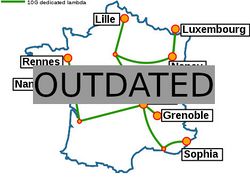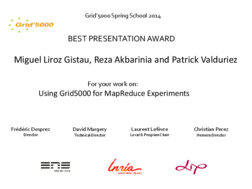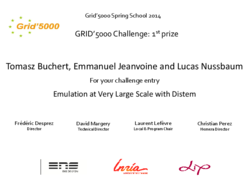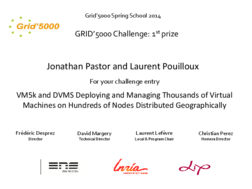Grid5000:Home: Difference between revisions
No edit summary |
No edit summary |
||
| Line 9: | Line 9: | ||
Key features: | Key features: | ||
* provides '''access to a large amount of resources''': 1000 nodes, 8000 cores, grouped in homogeneous clusters, and featuring various technologies: 10G Ethernet, Infiniband, GPUs, Xeon PHI | * provides '''access to a large amount of resources''': 1000 nodes, 8000 cores, grouped in homogeneous clusters, and featuring various technologies: 10G Ethernet, Infiniband, GPUs, Xeon PHI | ||
* '''highly reconfigurable and controllable''': researchers can experiment with a fully customized software stack thanks to bare-metal deployment features, and can isolate their experiment at the networking | * '''highly reconfigurable and controllable''': researchers can experiment with a fully customized software stack thanks to bare-metal deployment features, and can isolate their experiment at the networking layer | ||
* '''advanced monitoring and measurement features for networking and power consumption''', to provide a deep understanding of experiments | * '''advanced monitoring and measurement features for networking and power consumption''', to provide a deep understanding of experiments | ||
* '''designed to support Open Science and reproducible research''', with full traceability of infrastructure and software changes on the testbed | * '''designed to support Open Science and reproducible research''', with full traceability of infrastructure and software changes on the testbed | ||
Revision as of 22:46, 22 January 2015
|
Grid'5000 is a large-scale and versatile testbed for experiment-driven research in all areas of computer science, with a focus on parallel and distributed computing including Cloud, HPC and Big Data. Key features:
|
Latest publications from Grid'5000 users
Five random publications that benefited from Grid'5000 (at least 2925 overall):
- Anas Mokhtari, Baptiste Jonglez, Thomas Ledoux. Towards Digital Sustainability: Involving Cloud Users as Key Players. IC2E 2024 - 12th IEEE International Conference on Cloud Engineering, Sep 2024, Paphos, Cyprus. pp.126-132, 10.1109/IC2E61754.2024.00021. hal-04633237 view on HAL pdf
- Tom Hubrecht, Claude-Pierre Jeannerod, Paul Zimmermann, Laurence Rideau, Laurent Théry. Towards a correctly-rounded and fast power function in binary64 arithmetic. 2024. hal-04159652v2 view on HAL pdf
- Théophile Dubuc. Détection d'anomalies de latence dans les systèmes distribués avec eBPF. Système d'exploitation cs.OS. Ecole normale supérieure de lyon - ENS LYON, 2024. Français. NNT : 2024ENSL0109. tel-05064342 view on HAL pdf
- Thomas Firmin, Pierre Boulet, El-Ghazali Talbi. Asynchronous Multi-fidelity Hyperparameter Optimization Of Spiking Neural Networks. International Conference on Neuromorphic Systems (ICONS 2024), Jul 2024, Washington, United States. hal-04781629 view on HAL pdf
- Danilo Carastan-Santos, Georges da Costa, Millian Poquet, Patricia Stolf, Denis Trystram. Light-weight prediction for improving energy consumption in HPC platforms. Euro-Par 2024, Carretero, J., Shende, S., Garcia-Blas, J., Brandic, I., Olcoz, K., Schreiber, M., Aug 2024, Madrid, Spain. pp.152-165, 10.1007/978-3-031-69577-3_11. hal-04566184v2 view on HAL pdf
Latest news
Grid'5000 tutorial days in Lille
We are happy to let you known that tutorials around Grid'5000 will be organized in Lille on November 20th, 2014, with a few seats available for people outside Lille. All information on the dedicated web page.
Grid'5000 spring school now finished
The Grid'5000 spring school took place between June 16th, 2014 and June 19th, 2014 in Lyon. Three awards were given for presentation or challenge entries (the challenge entries ended as a tie):
|
Best presentation award to Miguel Liroz Gistau, Reza Akbarinia and Patrick Valduriez |
Best challenge entry to Tomasz Buchert, Emmanuel Jeanvoine and Lucas Nussbaum |
Best challenge entry to Jonathan Pastor and Laurent Pouilloux |
Grid'5000 sites
Current funding
As from June 2008, INRIA is the main contributor to Grid'5000 funding.
INRIA |
CNRS |
UniversitiesUniversity Joseph Fourier, Grenoble |
Regional councilsAquitaine |





